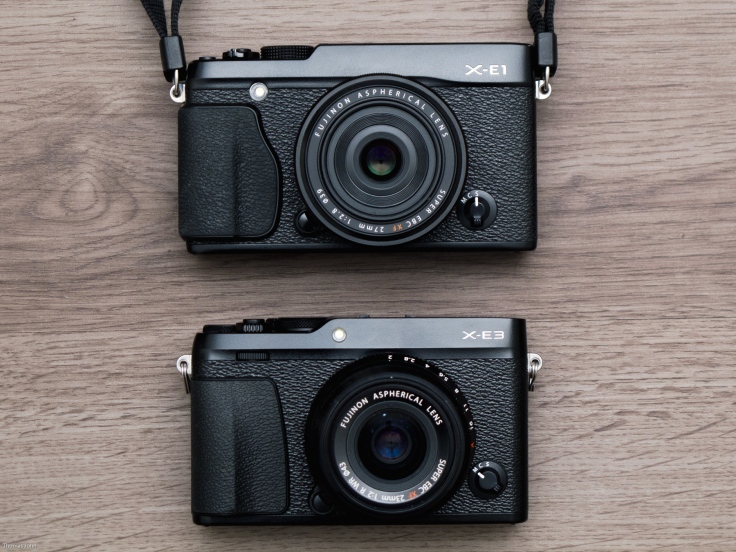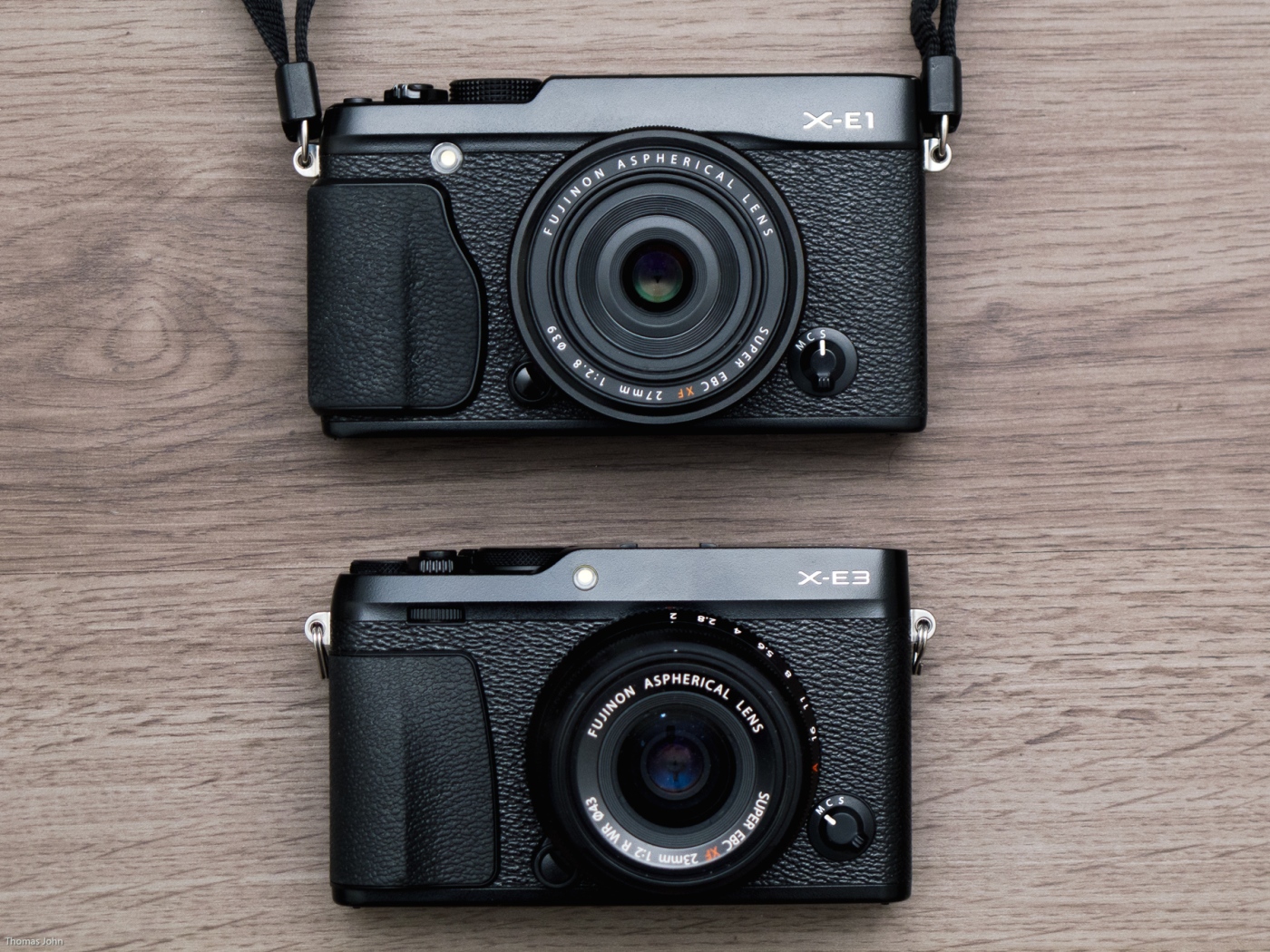Currently, I happen to have both these cameras at home so I thought this is a good opportunity to do a small comparison – between the first and the current incarnation of Fuji’s E-series bodies.
The X-E1 came out in late 2012. It was the second Fuji X system body of them all, after the system was launched with the X-Pro 1 earlier the same year. In late 2013 it was replaced by the X-E2. From then on, it took another four years until, in October 2017, the first X-E3’s hit the shelves. (Yes there was an X-E2s but that was, in fact, just an X-E2 with a substantial firmware update and a very few cosmetic changes.)

On these pictures, both bodies are seen with a lens of the same vintage – the 27/2.8 pancake is an older release from 2013 whereas the 23/2 appeared in 2017. Of course, all Fujinon X system lenses work on all Fuji X system bodies without any issue.
Today, as of early 2018, you can pick up a Fuji X-E1 on the used market for maybe 150 or 170 Euros here in Germany, whereas the asking price for a new X-E3 is 899 Euros. That’s more than 600 Euros difference. In fact, the X-E1 currently is the cheapest Fuji body (with built-in viewfinder!) that you can get at all. The camera you see on these pictures belongs to a good friend of me who just kept it alongside his newer bodies, and I could borrow it for a couple of weeks when my newly acquired X-E3 had to be sent in for a warranty repair.
So I gained some experience now with the old X-E1. Many of my recent blog postings featured the X-E1, such as Merry Christmas 2017, Olympus PEN Zuiko lenses for Fuji: Part 1 – Introduction, Part 2 – The 38/1.8 and Part 3 – The 100/3.5. They are all a testament to the X-E1’s great image quality and overall nice handling.
Without the X-E3, I did not miss that much, or did I?

But when I picked up my X-E3, I was instantly reminded that this was the Fuji body that I felt in love with! But let’s just see what differences and what similarities the two cameras share, below:
What are the differences, performance-wise?
- Obviously, the sensor. The Fuji X-E1 offers 16 MP, the X-E3 24 MP.
I have to say that the image quality of the X-E1 still can keep up well, but the difference in resolution can be felt if you want to print large or if you want to crop in post production. Here I did a direct comparison shootout between the two. - The Fuji X-E1 does not have yet a phase-detect auto focus system.
As such, it can only measure contrast of a give scenery but has no clue how far subjects are or in which direction they move.
In practice, you’ll be fine with AF-S and in daylight, if you are not a real action photographer. I never found the X-E1 really lacking here. However, don’t even dare to compare AF-C between these two bodies. No contest. - If you like to use manual lenses, the Fuji X-E3 makes it really easier for you.
First, it offers additional focusing aids such as Fuji’s unique digital split screen. (This is impossible on the X-E1 as it needs the sensor’s phase-detect pixels to work.) Also, the viewfinder magnifying function offers a clearer image, especially in low light conditions, and even the focus peaking feature that both bodies offer, works better with the X-E3. Your mileage might vary, but I actually find this is one of the big differences between the two bodies in practice. - The Fuji X-E1 struggles in really low light.
If you, for example, take night shots on a tripod. The viewfinder image gets coarse, the auto focus often does not work any more, and you can also forget to use the magnifying function to achieve focus. The X-E3 just has many more reserves here. This is not about image quality – both bodies deliver very good night shots – but more about handing and about the viewfinder image. - The Fuji X-E1 does not offer ISO 100 when shooting in RAW.
I know that the sensors of both cameras operate with ISO 200 as their native sensitivity, but if you want the best possible output with really clean shadows, switching to ISO 100 still can help.

What are the differences, body-wise?
- The X-E3 is a bit smaller. See the pictures.
- The X-E3 adds a second command dial in front of the body. Also, the command dials itself are now much nicer. The one on the X-E1 looks and feels like a weird plastic cog wheel.
- The X-E3 adds the little joystick and that makes selecting the focus point a breeze. Maybe I missed a trick here on the X-E1, but there I always had to press the AF button (bottom left) first before I could adjust the focus point on the four-way controller. The X-E3 offers direct access via the joystick, no button pressing whatsoever. A huge difference for me.
- The four-way controller is gone on the X-E3, as are some more buttons. To get some functions back that were previously on these buttons, a touch screen interface was added. For example for the selection of Fuji’s film simulation profiles. It works very well for me.
- The X-E3 has a slightly different viewfinder glass design, in practice I did not notice much difference. Also the size of the viewfinder image is virtually the same.
- The X-E3’s rear screen is a little bit bigger, but really not by much.
- The X-E3 omits the built in micro flash, but that makes the top deck much cleaner in design and also frees up space on the right side where the buttons and dials are.
- The X-E3’s shutter speed dial goes to 1 second, not just 1/4 like on the X-E1. You’d maybe rarely notice but it can make a bit of a difference in handling. Of course, both bodies offer the full range down to 30 seconds if you are in automatic mode or chose to adjust shutter speed via the command dial(s).
- The X-E3’s exposure compensation dial goes from +3 to –3, with an additional C (custom) setting. The X-E1 only offers +2 to –2.
What’s the same between the two?
- The general concept of the “rangefinder style” body remained the same.
- Overall operation feels similar, despite all the differences in detail that I listed above.
- Weight is pretty much the same in your hand, even if the numbers might vary by a few grams.
- Grabbing and holding the cameras feels very similar as well.
- Many design details, such as the threaded shutter button, on-off switch etc. remained also the same.
- Both cameras use the same type of batteries. (But only the X-E3 can be charged via USB as well, the X-E1 can’t!)
- On both cameras, the tripod mount is located at a rather bad position. It should be in line with the lens mount, but instead it’s way too close to the battery / card compartment.

My conclusion
As you can maybe already guess by reading through this blog post, most of the differences are rather subtle. Personally, I’d rate these four points the most important for me:
- The resolution – 24 instead of 16 MP is very helpful for me.
- The cleaner design with much less buttons and a better layout on the top deck. The whole camera feels much more polished to me.
- The joystick makes handling the camera and selecting auto focus points so much nicer.
- I really love the digital split screen.
Are these points worth more than 600 Euros of price difference?
Truth is, you can only answer that for yourself. Even the Fuji X-E3 is not exactly “expensive” when it comes to state-of-the-art mirrorless camera bodies. Yet, the X-E1 is a real bargain. There is no arguing around that. If you want to save money and thus not get the new X-E3, I’d personally jump to the X-E1 (and not the X-E2 or X-E2s), because here you’d save the most.
Cheers,
Thomas


I dont think the upgrade is worth it. I’ve been shooting with my trusty X-E1 for years now and often favor it over my X-T1 and Nikon D610 bodies… Its just so compact and easy to grab on the go. The extra MP would be nice, but for online portfolios its negligible. I’ve made many gorgeous 11×17″ prints in 16mp…I’d rather buy more glass instead of the new body.
Yes, I agree that one really has to check these days if an upgrade is “needed” or not. We don’t have 2004 any more where EVERY new digital camera was really a big step forward! Another example: A couple of days ago, Fuji just released the new X-T3. But the differences over the previous X-T2 are so subtle … again I can’t imagine that many photographers will really benefit a lot from those small changes …
That was my first Fuji. (X-E1). I hated the Slow or missed focus, even with firmware update, but I loved the response time of my X-T10. They improved it.
The X-E1 was my first Fuji & I loved it, so much so that even though I now have the XH1 & XT3 I also own an X-E3 which I use almost as a walkabout camera in Towns & Cities, whereas the other two are used as wildlife cameras. I mostly use it with the Laowa 9mm attached which is great in the narrow streets of medieval towns which I like to visit.
Thanks for your comment. Yes the X-E3 is a terrific small walkabout camera. I am a great fan of carrying only one single lens with me as often as possible. Keeps weight down and makes me also concentrate better on a certain viewing angle! Now the idea to use a fixed 9mm UWA lens for certain city trips sounds very interesting! So far I’ve always shied away from all these UWA lenses. Maybe I should rethink :)
You should give the Laowa a try, it’s great little (tiny) lens. I love it.